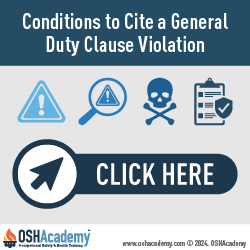The General Duty Clause (GDC)
When there are no specific violations covered by OSHA standards, employers may be cited under the OSHA Act Section (5)(a)(1), General Duty Clause (GDC) which says:
- "Each employer shall furnish to each of his employees employment and a place of employment which are free from recognized hazards that are causing or are likely to cause death or serious physical harm to his employees."
What OSHA must prove
To cite employers under the GDC, OSHA must establish that four basic conditions have been met:
- Responsibility: The employer failed to keep the workplace free of a hazard to which employees of that employer were exposed. OSHA must prove the employer was aware (or should have been aware, with reasonable diligence) of the hazardous condition but failed to mitigate it.
- Recognition: The hazard was recognized. OSHA must demonstrate that the employer exposed employees to a hazard that is recognized in the industry or by the employer. A "recognized hazard" is a workplace condition or practice to which employees are exposed, creating the potential for death or serious physical harm to employees.
- Consequence: The hazard was causing or was likely to cause death or serious physical harm. OSHA needs to show that the hazard could lead to significant injury, illness, or death if not addressed.
- Abatement: There was a feasible and useful method to abate (correct) the hazard. OSHA must identify reasonable, feasible measures the employer could have implemented to eliminate or reduce the hazard.
- Failure to address ergonomic hazards. Employers may neglect to identify or resolve workplace conditions that contribute to musculoskeletal disorders (MSDs). For example, in environments where employees perform repetitive tasks, such as assembly lines or data entry, failing to provide adjustable workstations, ergonomic tools, or regular breaks can result in repetitive strain injuries like carpal tunnel syndrome or tendonitis. Such hazards fall under the General Duty Clause when no specific OSHA standard applies.
- Exposure to extreme temperatures. Employers who require employees to work in dangerously hot or cold conditions without adequate protective measures may violate the General Duty Clause. For example, in extreme heat, failing to provide water, shade, and breaks can lead to heat exhaustion or heatstroke. Similarly, in cold environments, neglecting to supply insulated clothing or heaters may result in frostbite or hypothermia. These omissions can endanger workers' health and safety, making them a violation.
- Inadequate workplace violence prevention. When employers fail to take proactive steps to mitigate the risk of workplace violence, especially in high-risk industries like healthcare, retail, or public service, it can lead to preventable harm. For example, neglecting to train employees on de-escalation techniques, install security measures, or establish protocols for responding to threats creates an unsafe environment. Such lapses are actionable under the General Duty Clause if the hazards are recognized and feasible solutions exist.
Knowledge Check Choose the best answer for the question.
4-4. When there are no specific OSHA standards that address a violation, employers must comply with _____.
You forgot to answer the question!

